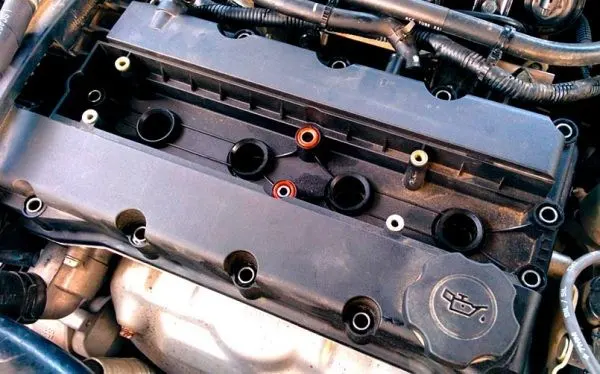The valve chamber cover of any engine is fastened to the block cover with multiple bolts. The rubber gasket is located between the lid and the cylinder head and is resistant to the effects of technical fluids and sudden temperature changes. The laying will age, the elasticity will decrease, and tiny cracks will appear. As a result, oil seeps into the engine compartment and dust and dirt adhere to these areas.
It is essential to replace the gasket as soon as possible and keep a close eye on the overall condition of the engine to prevent points of failure. It is generally recommended to do it after driving 7000-15000 km as this will fundamentally eliminate the possibility of oil leakage and prevent problems with the timing belt and engine. In other cases, it is also necessary to replace the rubber gasket (usually at the same time as the cylinder head (GBC) repair:
Eyebrows between the combustion chambers. This condition occurs due to improper bolt tightening or weakened contact pressure due to overheating of the engine. Signs – violation of the internal combustion engine cold start, heating motor instability.
Exhaust gases infiltrate the cooling system and heat the antifreeze. Signs – Air bubbles in the expansion tank, whitish exhaust gas, frequent cooling fan running.
The oil enters the cooling system. Signs – Oil stains under the expansion tank and radiator cover.
The gasket loses its tightness. Improper installation or temporary wear. Signs – Oil spots appear on the engine.
The main types of HBC gaskets
The following types of gaskets are installed in internal combustion engines:
Asbestos. Resilient, elastic and able to withstand temperature rises to very high limits. For added strength, it is usually reinforced with metal rings. They are inexpensive, but they also have some drawbacks: they are not resistant to vibrations, wear out quickly, and the sealing becomes worse during work.
Nonsense. More commonly used than previous sealants but more expensive. The frame is more susceptible to all kinds of damage, deformation, and vibration and is designed for long-term work.
Metals and bimetals. Made of multiple layers of metal, or additionally containing sealing elastomers. It is considered to be the most popular and widely used in modern machines.
Type of sealant
Valve chamber covers should only be sealed with specific tools; Ordinary sealants cannot maintain the sealing effect for a long time. They also vary in composition and attributes:
Anaerobic. The base material is the synthetic polymer dimethacrylate. Anaerobic conditions are required for hardening, i.e., the absence of oxygen. Using this compound is convenient for the master – it can be applied slowly and conveniently. Product residues that have come off the seams must be removed immediately – they are still half-dead and can get into the internal combustion engine.
Silicone. Silicone-based compounds are more commonly used to seal valve chamber covers and other automotive nodes. It is manufactured on the basis of silicon compounds, which solidify under the influence of air humidity. For high-quality fastening of the details, they should not be connected to each other immediately after application, but after 5-15 minutes (so much sealant is needed to start setting). The application of silicon compounds is not as precise as that of anaerobic types. Larger cracks and crevices can be compacted. Another advantage is the chemical inertness of silicone: it does not destroy rubber and any other materials because it does not react with it. When sealing valve chamber covers, it’s best to buy tools that are 100% silicone and free of other additives.
Polyurethane. It is characterized by strong adhesion to metals, rubber, and other materials. It can be used for fastening parts and sealing parts. Durable, resilient, and long-lasting, available in different colors for easy use and removal.
Sealing requirements for valve covers
Heat resistance is the primary characteristic that sealants should have. High temperature is the ideal working condition for the tool, and the higher the heat resistance, the better. Other specifications of sealant:
Chemical resistance, petrochemical resistance. Sealants must not deteriorate due to the following aggressive compounds: transmission fluids and oils, brake fluids, solvents, antifreeze.
Resistant to vibration, mechanical load, low temperature. If the strength and elasticity are insufficient, the seams will crack quickly. The sealant must be frost resistant because in winter, when the car is parked in the garage, the sealant must do its job.
Easy to use. The sealing of the valve chamber cover is quite difficult, so the packaging of the product must be the most convenient to work with. It turns out that small watering cans work best when used, on the contrary, hard tubes like toothpaste are uncomfortable to use.
Optimal capacity. If you only need to press down on the bonnet, the amount of sealant is minimal and there is no need to buy a large package.

